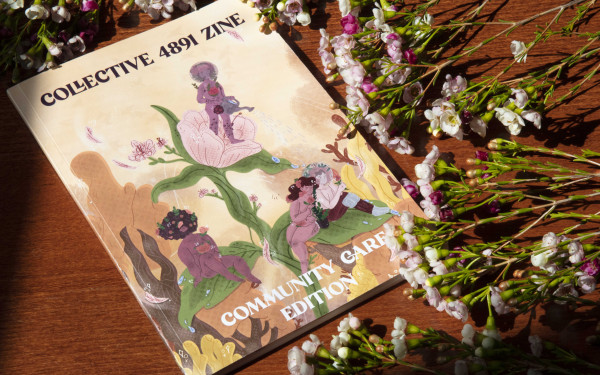Welcome to the Zine Scene
Expozine Gives Artists the Exposure
Église Saint-Denis was packed this weekend as people milled between tables upon tables of zines, poetry, graphic novels, and so much more.
The Expozine scene was in full swing Nov. 12 to 13.
Amidst the hustle and bustle, finding one of Archive Montreal’s s co-founders, Louis Rastelli, was a difficult task. One vendor selling zines full of poetry said to “keep an eye out for the guy that’s constantly swiveling his head around the room.”
Turns out that this description was completely accurate. Rastelli was constantly occupied, ensuring that the event ran as smoothly as possible.
All ten co-founders of Archive Montreal were small press zine-makers, poets and writers before organization’s inception. Their mandate is to promote and preserve the independent arts milieu.
“We wanted to build an archive of all this stuff. We wanted to develop promotional projects such as Expozine,” Rastelli said.
Today, Archive Montreal has archived thousands and thousands of these kinds of works. Although it has created several subsets, including Distroboto, Expozine is specifically for small press and publishers of graphic novels, poetry and short literature.
“If there aren’t events like this, we just wouldn’t know how many creators of this work there really are,” Rastelli said. “It’s important that Expozine exists, so that artists have a place to show their work. Otherwise they may lose interest and no longer wish to continue publishing.”
Rastelli admitted that a lot of people had doubted that Expozine would stick around for more than two or three years. This year was its fifteenth edition.
“The Internet was supposed to replace all of it, but it’s really just complementary,” he explained. “It can’t replace actual print and art.”
In fact, Rastelli had visited the Expozine website to check in on the web links of all of the publishers from a few years back only to find that a lot of the websites had been shut down. “That’s a sign of how ephemeral the web is and the importance of actually making zines and books.”
Despite Expozine’s success, they’ve been having issues with finding an appropriate venue that would be able to accommodate all of the vendors and guests. The size of the space isn’t the only issue. The space where Expozine happened last year was literally falling apart. The future of the fair, and virtually any other organization of Archive Montreal is dependent on finding the space.
“We can’t just go on forever in the basements of crumbling churches,” Rastelli stated, jerking his head towards a floor full of artists. “These people have put so much effort into their work and they deserve a better place.”
Among these artists and writers was Jillian Fleck, author of her first published graphic novel, Lake Jehovah.
Dealing with themes of breaking up, hooking up, feeling anxious and anticipating the end of the world, Lake Jehovah is a graphic novel that is definitely worth picking up for a good read, if only for its demons.
Jay, a genderqueer individual, is the main character of this story. Xe experiences a traumatic breakup, where xe predicts the apocalypse and soon after falls into a six-month coma. Xe wakes up only to realize that the world around xim has changed, including xis newfound fame as an end-of-times prophet.
The bottomless lake in the story is the figure that drives the plot forward. “You’re drawn to things that are probably not the best for you like bad relationships and people, and encounters,” Fleck explained. “That kind of gravitational pull those things have on you is what the lake had on some of the characters in the story.”
Lake Jehovah is full of the fear of abandonment and a heck of a lot of “I don’t know.” Because who the hell knows how to deal with difficult thoughts, right?
Fleck captured the abstract emotion of loneliness wonderfully in just her illustrations; words were unnecessary with the imagery displayed in Fleck’s panels, creating an atmosphere that readers will feel whether they relate to the situation or not.
Fleck even inserted some of her personal experiences into this graphic novel.
“PJ Harvey was also a major influence for me while writing and illustrating this book,” Fleck said of the musician. “Especially for the last third of it. She really illustrated what I was trying to say in the novel.”
Originally from Calgary, Fleck was thrilled to be at Expozine. “I really enjoy how excited everyone is,” Fleck said. “They’re actually passionate about what they’re seeing and wanting to both support and participate. To see a lot of connections being made.”
Concordia student and illustrator Gabor Bata was also at Expozine, showing some of his work. He explained that Montreal doesn’t have as many opportunities for illustrators and small press artists like the city of Toronto would have.
“I’ve been to a number of small press, indie comic conventions, like the Toronto Comic Arts Festival,” Bata said. “Expozine gives people an outlet to find their footing in the world and make connections.”
Bata noted how he had met several people at Expozine that he will most definitely work with in the future.
“Expozine sort of informs you on what people are flocking to in the art and small press world, so it’s insightful that way,” Bata continued. As one of the creators behind the zine Totum, Bata pointed out some artists that gave him some new ideas for his own work.
“The point of Expozine is inclusion,” Bata said. “I think they want to get the more inexperienced and newer artists running around in Montreal. Just shining a light on fresh voices.”

web_900_600_90.jpg)
_600_832_s.png)


1_600_375_90_s_c1.jpg)

3_600_375_90_s_c1.jpg)